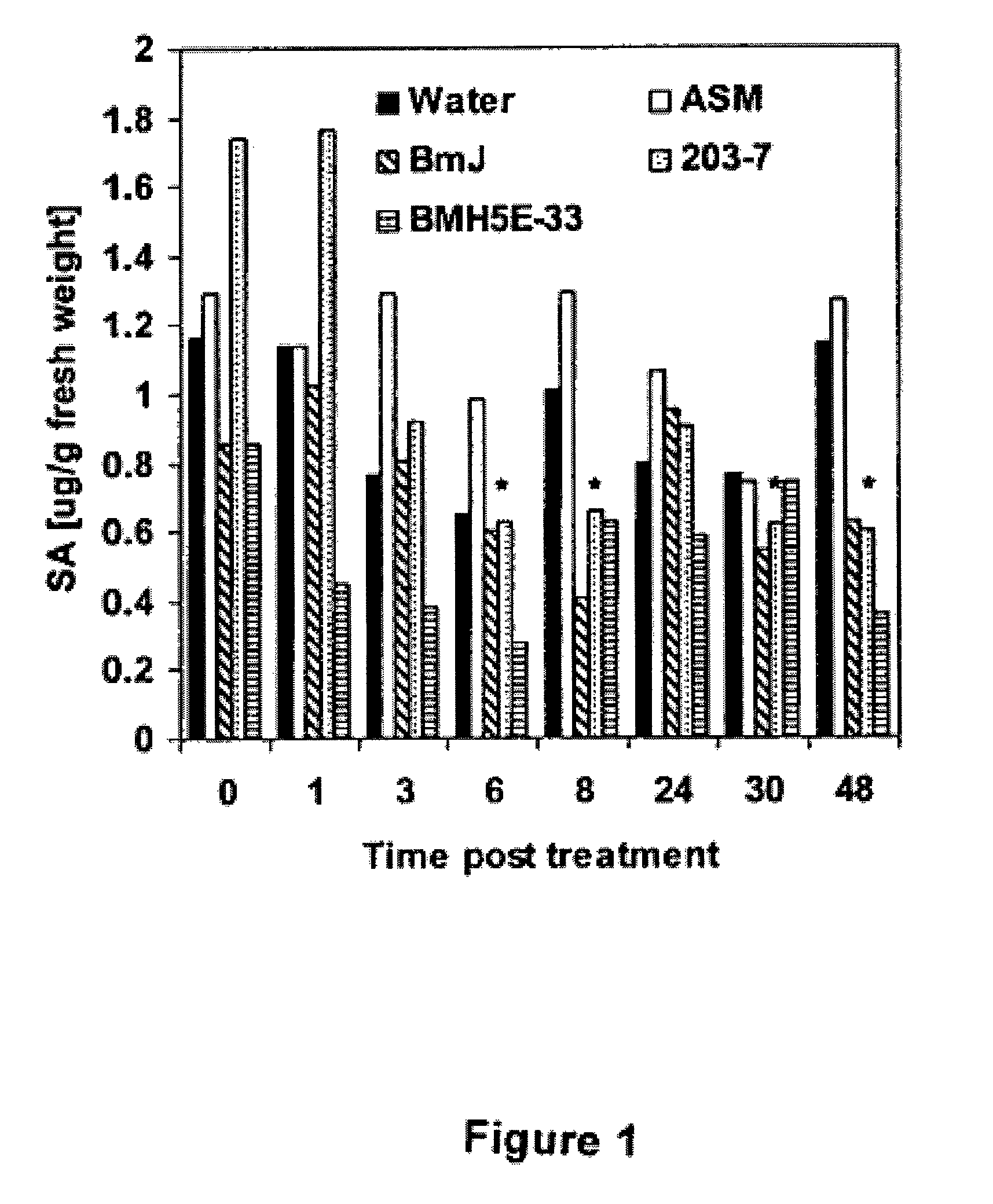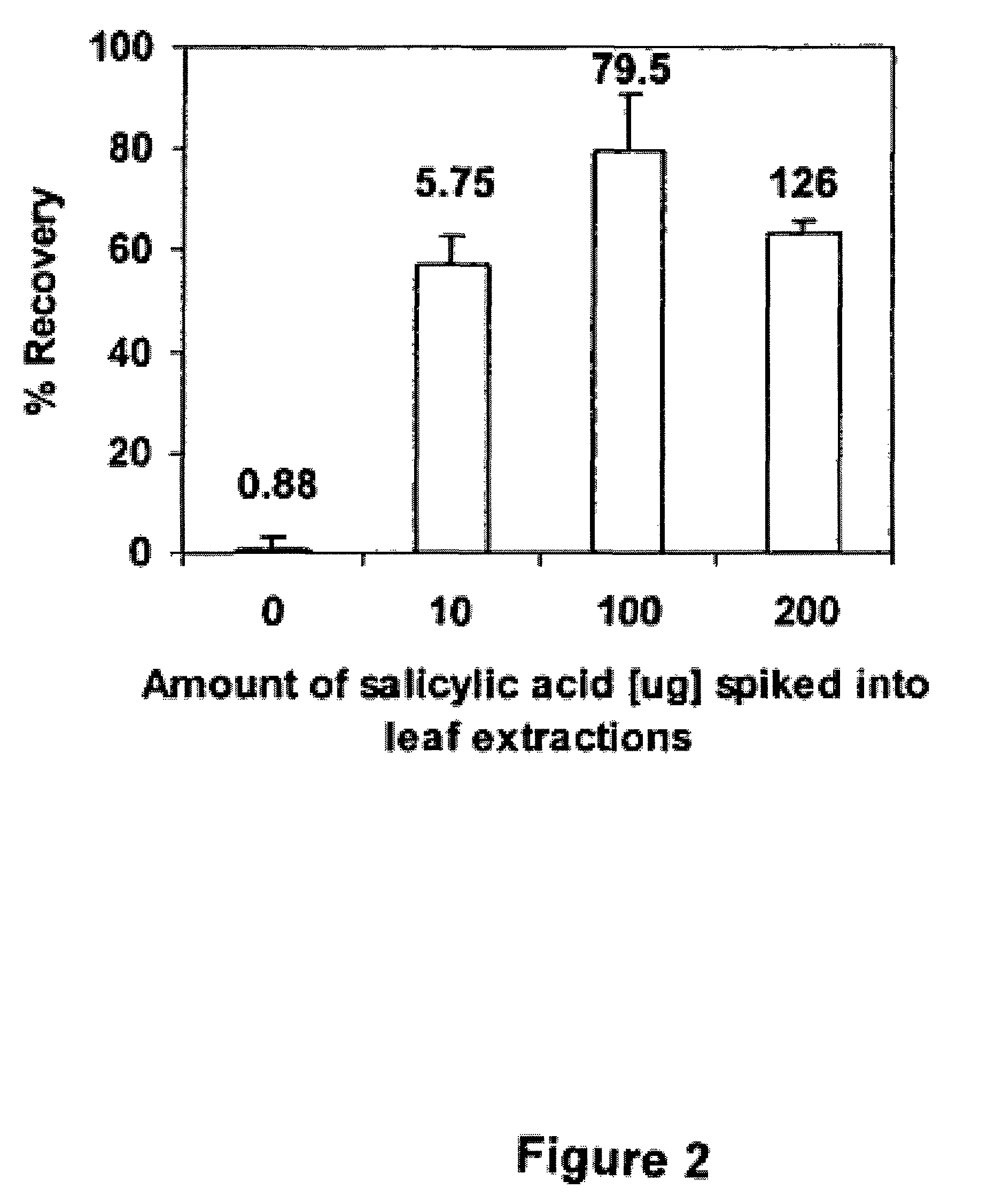Bacillus isolates and methods of their use to protect against plant pathogens
a technology of bacillus and isolates, applied in the field of inducing pathogen resistance in plants, can solve problems such as necrotic cell death, and achieve the effect of enhancing plant growth
- Summary
- Abstract
- Description
- Claims
- Application Information
AI Technical Summary
Benefits of technology
Problems solved by technology
Method used
Image
Examples
example 1
Isolation and Testing of Bacillus mycoides Isolate BmJ
[0101]Bacillus mycoides isolate J (BmJ) was isolated from sugar beet leaves as follows. Leaf samples from sugar beets plants that had reduced infection by Cercospora beticola (CB), the fungal pathogen that is the causal agent of Cercospora leaf spot, were collected from a sugar beet field. in Sydney Mont. The leaves were washed and pasteurized. Endospores were isolated from the pasteurized wash. The endospores were grown and tested for the ability to induce resistance to CB in sugar beets. One of the isolates, BmJ, was selected for use as a biological control agent because it provided the best control of isolates tested in early glasshouse trials.
[0102]In preliminary studies, a spontaneous Rifampicin resistant mutant of BmJ, that did not differ in growth rate or disease control capabilities from BmJ, was utilized in repeated attempts to isolate BmJ at 3, 6, 9, and 18 d post treatment from distal untreated and treated sugar beet l...
example 2
Testing of BmJ in Growth Chamber Experiments
BmJ Preparation
[0103]B. mycoides isolate J (BmJ) cells, originally isolated from sugar beet leaves from Sidney, Mont. in 1994, were stored at −80° C. in 10% glycerol and 1% tryptic soy broth (TSB) (Difco). For fresh cell preparations, BmJ was cultured in TSB for 48 h (28° C.). Cells were centrifuged 15 min at 10000 g (4° C.), washed with sterile water (2×), then resuspended in distilled water. The optical density was adjusted to A600 1.0, then diluted 1:2 based on optical density curves confirmed by dilution plating. This optical density and dilution provided for approximately 1×108 cfu / ml. The precise number of cells was not determined due to the chain-forming nature of the organism. For experiments testing dead cells, BmJ was autoclaved in water for 30 min following washing. Autoclaved cells were tested for lack of viability by plating 100 microliters onto three plates of 50% tryptic soy agar (TSA). For field studies, either fresh BmJ ce...
example 3
Testing of BmJ in Field Studies
Field Studies
[0110]Field studies were conducted at the Eastern Agricultural Research Center in Sidney, Mont. from 1996 through 2003. Sugar beet variety ‘Beta 1996’ was planted the first year, VDH 66140 was planted the second year, HH88 the third year, KW2262 the fourth year and Beta 2185 the fifth, sixth, and seventh years. All cultivars were equally susceptible to C. beticola infection (BetaSeed, Shakopee, Minn., U.S.A.). A spray-dried formulation of BmJ, suspended in water (108 cfu / ml), was used the first four years. In the last two years, freshly grown, washed cells were harvested from a 24 h tryptic soy broth culture grown at room temperature and prepared as described above, and applied to the plants. Fungicide treatments included triphenyltin hydroxide (TPTH, SuperTin, Griffin L.L.C.), propiconazole (Tilt, Syngenta Crop Protection, Inc) and tetraconazole (Eminent, Sipeam Agro USA Inc.) that were applied at 390, 253 and 876 g ai ha−1, respectively....
PUM
| Property | Measurement | Unit |
|---|---|---|
| diameter | aaaaa | aaaaa |
| diameter | aaaaa | aaaaa |
| diameter | aaaaa | aaaaa |
Abstract
Description
Claims
Application Information
 Login to View More
Login to View More - R&D
- Intellectual Property
- Life Sciences
- Materials
- Tech Scout
- Unparalleled Data Quality
- Higher Quality Content
- 60% Fewer Hallucinations
Browse by: Latest US Patents, China's latest patents, Technical Efficacy Thesaurus, Application Domain, Technology Topic, Popular Technical Reports.
© 2025 PatSnap. All rights reserved.Legal|Privacy policy|Modern Slavery Act Transparency Statement|Sitemap|About US| Contact US: help@patsnap.com



